
Remote and hybrid work has become the new working norm and businesses are embracing flexible work arrangements by finding new ways to stay connected. Cloud tools like Microsoft Teams, which has 320 million users, are already a preferred choice for online meetings and chats, it’s now become a game-changer for phone calls too. Operator Connect and Direct Routing are two ways to integrate external calling functionality directly within your Microsoft Teams environment.
But which option should you choose?
Let’s explore Operator Connect vs Direct Routing to help you make an informed decision and ditch the desk phone for good!
What is Direct Routing for Microsoft Teams?
Microsoft Teams Direct Routing, often referred to as Direct Routing, is the core technology that enables you to connect your existing phone lines, which may be PBX or PSTN, to Microsoft Teams. It involves setting up Session Border Controllers (SBCs) and configuring the connection. Users can make and receive calls directly within the Teams interface utilizing their existing phone numbers and telephony infrastructure.
There are two main ways to utilize Direct Routing:
Self-managed Direct Routing
Here your organization manages the entire setup, configuration, and ongoing maintenance of the SBCs and the connection to Teams. Self-managed Direct routing requires you to have a strong in-house IT team with expertise in voice and network management.
DRaaS (Direct Routing as a Service)
It is an ideal solution for organizations that want to use Teams for external calling but don’t want to indulge in the heavy lifting associated with Direct Routing.
In Direct Routing as a Service, a third-party service provider takes care of the procurement and configuration of the SBCs, as well as the connection to Teams. They may also offer ongoing maintenance and support. This is a good option for organizations that want the benefits of Direct Routing but lack the internal resources to manage it themselves.
For better understanding, you may consider Self-managed Direct Routing as the “do it yourself” option and DRaaS as the “managed service” option.
How Does Direct Routing Work?
Direct Routing leverages a Session Border Controller or SBC, either hardware or software appliance, that acts as a bridge between your organization’s telephony infrastructure and Microsoft’s network.
When a user initiates an external call through Teams, the call is routed through the Session Border Controller to the PSTN or PBX, where SBC translates protocols and ensures secure communication between the two parties. The Vice-versa i.e. routing of call from PSTN or PBX to SBC happens in case of incoming calls.
Let’s discuss the working of direct routing in more detail.
In Direct Routing, an SBC acts as a ‘border guard’ that bridges the gap between Microsoft Teams and your existing phone carrier. It makes sure that both the entities, i.e. Teams and your Carrier, experience a harmonious interaction. The below diagram illustrates the specific setup where on one side of the border is your traditional phone line and on the other side is a Teams user. Here SBC acts as the control center ensuring smooth communication and presenting its pivotal role.
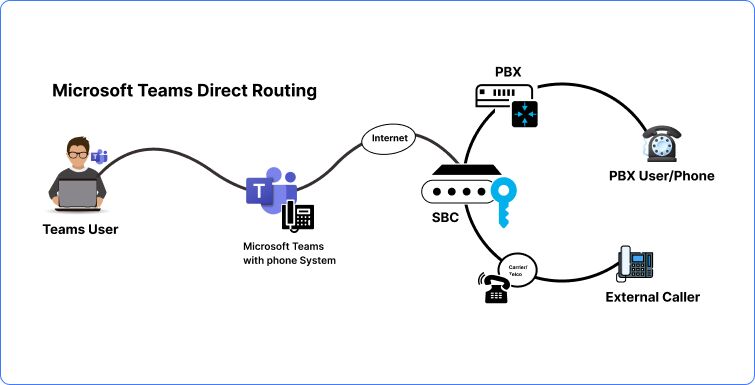
How to Setup Direct Routing?
Getting started with Direct Routing requires you to fulfill one prerequisite from Microsoft – you should have the Microsoft Teams Phone license. This unlocks the calling features within Teams.
Once you have the licenses and your phone system set up, Direct Routing can be easily provisioned for all your Teams clients (desktop, mobile, etc.) and even common area phones.
If you wish to add new phone numbers to your Teams setup, then you can simply follow the standard process. In case of porting existing numbers – your PBX provider remains the same, and only the connection gets rerouted to Teams.
What are the Benefits of Direct Routing?
There are a wide range of benefits offered by direct routing that help streamline and optimize your business’s communication. Let’s take a closer look at each of these benefits:
1. Facilitates Unified User Experience
Direct Routing integrates calling capabilities directly into Microsoft Teams which eliminates the need for separate calling apps. This helps maintain a consistent user experience and eliminates frustrating app-switching.
2. Provides Global Reach
Direct Routing extends telephony coverage to regions beyond those provided by Microsoft Calling Plans. This means a business with international teams and clients can ensure consistent communication regardless of location.
3. Supports Customizable Integrations
Direct Routing facilitates integration with various line-of-business applications. This flexibility allows a smoother flow of information thus boosting communication and collaboration workflows and enhancing efficiency.
4. Offers Retention of Existing Numbers
With Direct Routing, there’s no need to leave your established business phone numbers. You can seamlessly port your existing numbers to Teams to ensure continuity in communication and minimize any impact on customers, stakeholders, and partners.
5. Makes Scaling Easy
Direct Routing allows organizations to add or remove users as needed easily. This ensures that your telephony solution adapts according to your business requirements.
6. Fosters Cost-effectiveness
Direct routing allows you to leverage your existing telephony connections, potentially saving costs as compared to alternate solutions.
7. Presents Advanced Routing Options
With Direct Routing, you have granular level control over how the call routes. You can set up complex rules based on time, caller location, team, or department to ensure that calls are directed to the most appropriate recipient every single time.
Challenges with Direct Routing
So we just learned the many benefits of Direct Routing, let’s flip to the other side of the coin i.e., the challenges associated with Direct Routing.
1. Complex Installation
Direct Routing involves bringing together a few different phone-related elements. This includes Microsoft Teams Phone, Session Border Controller, services of your phone company, and your existing phone equipment.
This can be quite complicated for someone used to just managing Teams itself which is why it’s often a good idea to get help from experts called resellers or system integrators. They can make sure all parts work together seamlessly and you don’t have any communication problems down the line.
2. High Upfront Costs
While potentially cost-effective in the long run, Direct Routing comes with a few primary needs, including:
- Session Border Controller: The cost of SBC can vary depending on factors such as capacity, features, and brand. Additionally, organizations may need multiple SBCs for redundancy and scalability, further increasing upfront expenses.
- Hardware and Software: Additional hardware and software components such as servers, gateways, routers, and other network equipment may be required to support Direct Routing. This cost can become huge, especially in large-scale deployments with complex setups.
- Licensing Fees: Licensing costs associated with SBC software, Microsoft Teams licenses, and potentially other related software licenses depending on the specific configuration and requirements also add to the initial costs when setting up direct routing.
- Training and IT expertise: Initial deployment of Direct Routing also entails hiring IT experts and training IT staff or end-users on using the new telephony solution to its full potential. Organizations need to invest in these areas to kickstart their calling experience with Direct Routing.
3. Requires PowerShell Administration
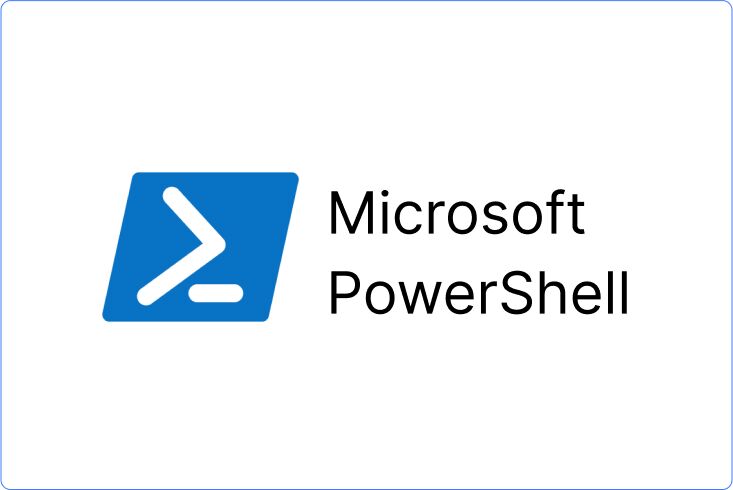
While Direct routing offers great control, setting it up isn’t as easy as clicking a few buttons. There’s no user-friendly GUI i.e. graphical user interface, rather, IT teams need to use a special tool called PowerShell, which works by typing commands in text format. it is very crucial to get the commands exactly precise to make sure things work just right.
For many, this may feel like the difference between using a modern smartphone and an old-school flip phone. Because the setup is tricky, it is a good idea to have someone with prior experience.
Direct Routing Pricing
Pricing of Direct Routing typically includes costs associated with the various components involved in the setup, including:
- Configuration and maintenance of the Session Border Controller
- Potential licensing fees
It is important to note that the pricing of Direct Routing differs from one provider to another.
What is Operator Connect for Microsoft Teams?
An alternative to Direct Routing, Operator Connect is another way to connect Microsoft Teams with a phone service. It’s a telecom-operator-based service that allows organizations to select their preferred operator from a list of Microsoft-approved vendors directly within the Teams admin center.
So, here, you choose a Microsoft-approved carrier to handle your phone service and connection to Teams. In contrast, with DRaaS, you have the flexibility to choose any carrier you want, as long as they offer Direct Routing functionality.
While both DRaaS and Operator Connect enable integrating phone service with Microsoft Teams, they take different approaches and offer distinct functionalities.
- DRaaS focuses on providing a managed service for setting up direct routing. This gives you more control and customization over your calling experience in Teams.
- Operator Connect is designed to simplify the integration process by leveraging pre-approved operators. These operators handle the entire call infrastructure, offering a standardized experience with less configuration needed on your end.
Insight – It’s important to note that Microsoft doesn’t select carriers to become “Operators”. The carrier makes the decision and must undergo Microsoft’s approval processes.
How Does Operator Connect Work?
When you use Operator Connect for Teams calling, the selected Operator manages all infrastructure layers and establishes a direct link to Microsoft’s cloud. This frees you from managing the complexities of phone infrastructure, enabling you to focus on using Teams for communication and collaboration.
Below is an illustration of the primary role of Operators in delivering calling services for Microsoft Teams.
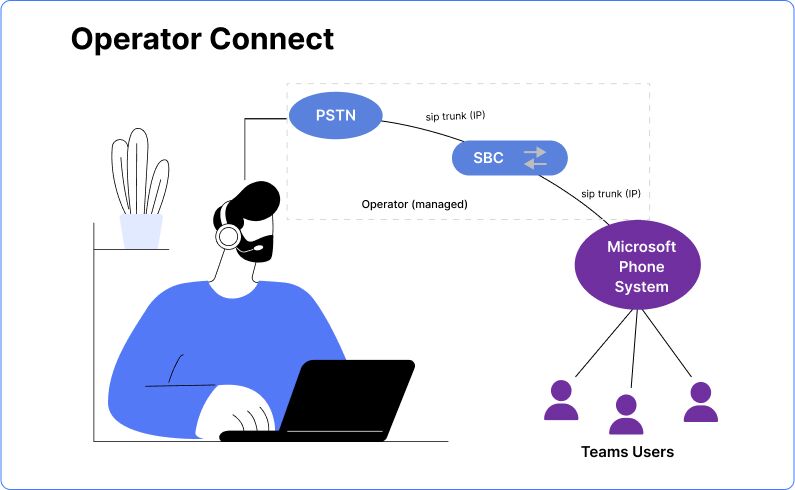
What are the Benefits of Operator Connect?
1. Strict Operator Selection
Microsoft selects its Operator Connect partners carefully ensuring flawless compatibility between your current phone system and Teams. These selected partners adhere to stringent security and government protocols, offering reassurance regarding the integrity of your telecommunications infrastructure.
2. Ideal for Businesses Seeking Simplicity with Savings
Operator Connect is ideal for organizations with specific needs. It caters to those who require more functionality than basic calling plans but lack the resources for a complex Direct Routing setup. Operator Connect simplifies the integration process offering potential cost-savings which makes it an attractive option for small to mid-sized companies with limited resources and expertise.
3. Pick Your Provider
When setting up Operator Connect, you have the flexibility to choose a phone company as per your suitability. The first way could be that you can continue with your current telecom provider, given that they are already a part of the Operator Connect Program. However, if that is not the case, then you can choose from the list of certified providers from within the Teams Admin Center. You can also compare different providers based on their features and functionalities, support services, reputation, and pricing to make an informed decision.
4. Easy Setup
Compared to Direct Routing, the deployment of Operator Connect follows a structured and streamlined approach. Integrating a certified telecom provider with Teams is also a simple process. In fact, it often entails just a few clicks within the Teams Admin Center.
Unlike other methods, Operator Connect eliminates the need for a separate SBC deployment and bypasses the complexity of text-based administration with PowerShell. As a result, the workload for IT teams involved in the deployment is significantly minimized.
5. User-Friendly Administration
Another significant advantage of Operator Connect is the user-friendly interface it offers. The Teams Admin Center acts as your central hub for managing all things calling in Teams. Within the Teams Admin Center, administrators can effortlessly configure phone numbers, onboard users, and oversee the telephony experience for both internal and external callers.
This empowers IT teams to manage calling efficiently, freeing them up to focus on other priorities. However, there still may be an occasional need to use the legacy text-based PowerShell interface, but this is the exception, not the rule.
6. Potential Cost-Effectiveness
With Operator Connect, the inclusion of Session Border Controller (SBC) functions and the reduced need for integration with an on-site PBX mean minimal hardware and software setup or configuration. While some organizations may opt to enlist expert assistance for transitioning to Teams Phone, the overall cost of deploying Teams Phone is expected to be lower.
Operator Connect Challenges
1. Restricted Availability in Certain Regions
Operator Connect, while a relatively recent offering, was initially introduced in North America, Western Europe, and specific regions of Asia. However, its availability may be limited in certain geographies.
In some areas, Operator Connect may not be accessible at all, while in others, prominent telecom providers are still in the process of integrating and certifying the service for their customers. Furthermore, the service is delivered through Azure data centers, which could naturally restrict access in remote areas of the world.
2. Several Providers Are Yet to Join
Deploying Operator Connect entails a significant investment of time and resources for telecom providers, as it necessitates a formal agreement with Microsoft. As a result, not all providers have opted to commit to the integration process, rendering them unavailable as options for Teams customers.
This can pose challenges for businesses interested in utilizing Operator Connect but locked into multi-year contracts with telecom providers that have yet to embrace the service. In such scenarios, transitioning to a compatible provider to access Operator Connect entails tasks like number porting, billing management, and other logistical hurdles that may deter businesses from making the switch.
3. Limited Connectivity Options for Existing Equipment
Due to its cloud-based nature, Operator Connect does not involve traditional phone lines terminating at a customer’s local office. Consequently, enterprises lack the means to integrate their existing phone systems or PBXs since there are no local phone lines available for sharing. In contrast to Direct Routing, where the Session Border Controller (SBC) resides on-premises,
Operator Connect utilizes a centrally deployed SBC in the cloud. While Microsoft has recently introduced solutions like the SIP Gateway to enable the integration of certain equipment such as fax machines and specific SIP phones, this solution does not facilitate the coexistence of an old phone system alongside Teams. Achieving such a level of integration still necessitates the use of Direct Routing.
Operator Connect Pricing
Operator Connect is a service without its own separate cost; however, you will incur charges from your chosen operator for connectivity, phone numbers, and usage.
To utilize Operator Connect, your Microsoft 365 users must have one of the following licenses:
- Office 365 E3 + Teams Phone Standard: $36 per user per month, inclusive of PSTN Audio Conferencing.
- Office 365 E5: $57 per user per month, which includes Teams Phone Standard and PSTN Audio Conferencing features.
Operator Connect vs Direct Routing: Key Differences
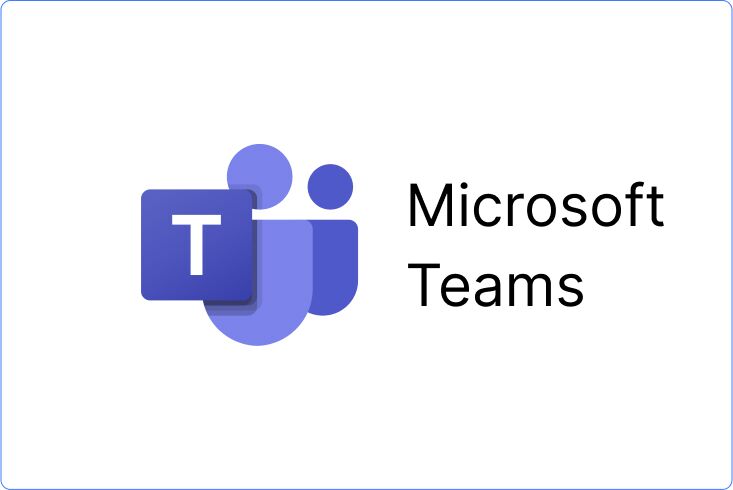
Choosing the right solution for integrating phone calls into Microsoft Teams depends on your specific needs and technical expertise. Here’s a breakdown of the key differences between Operator Connect and Direct Routing, along with practical examples to illustrate each point:
Deployment Complexity

Operator Connect: The deployment of Operator Connect is streamlined and user-friendly. Setting up phone numbers and users typically involves a few clicks within the Teams Admin Center.
Direct Routing: The deployment of Direct Routing is more complex and requires technical expertise to configure a Session Border Controller (SBC).
Example: A small marketing agency with limited IT resources would likely benefit from Operator Connect’s user-friendly setup. They can quickly activate calling functionality without needing to invest in additional hardware or involve IT experts extensively.
Management Interface

Operator Connect: Leverages the familiar Teams Admin Center for managing phone numbers, users, and calling features. This is a graphical interface (GUI) with icons and menus, similar to what you’d find on most modern applications.
Direct Routing: This may require using PowerShell for configuration and troubleshooting. It’s like writing code where specific commands need to be typed precisely to achieve desired results.
Example: A large company with a dedicated IT department experienced in PowerShell might be comfortable managing Direct Routing. They have the resources and expertise to handle the more technical aspects of configuration and troubleshooting.
Integration Flexibility

Operator Connect: Offers limited customization options as it relies on features provided by the chosen certified carrier. It is like a pre-set menu, where you can choose from what’s offered, but modifications might not be possible.
Direct Routing: Provides more granular control over call routing, security settings, and integration with other business applications.
Example: A healthcare organization with specific call routing needs for different departments might find Direct Routing more suitable. They can customize how calls are directed based on factors like urgency or patient type.
Cost Structure

Operator Connect: Typically follows a subscription model i.e. per-user, per-month subscription fee that includes phone numbers and calling minutes. The cost is predictable based on usage.
Direct Routing: Pricing can vary depending on chosen phone line costs, SBC fees, and IT administration time. This is more like a pay-as-you-go phone plan – costs can fluctuate based on usage and configuration needs.
Example: A startup with a limited budget might prefer the predictable pricing of Operator Connect. They can easily estimate their monthly costs based on the number of users and calling needs.
Operator Connect or Direct Routing: Which Strategy Should You Choose?
Statistics reveal that Microsoft Teams customers are concentrated in Information Technology and Services (14%), Computer Software (6%), and Higher Education (5%).
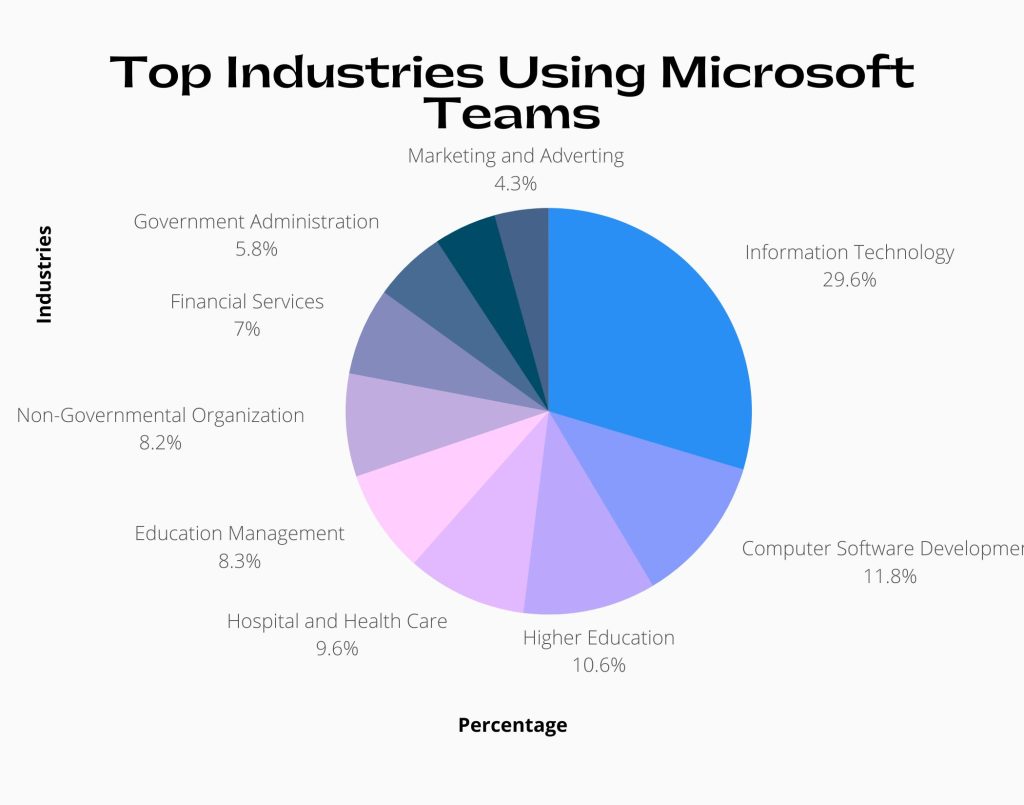
When to Choose Direct Routing?
1. Companies with Long-Term Contracts
Direct Routing could be the ideal solution if you’re locked into a contract with an existing PSTN provider. It allows you to continue using your current phone system as your telephony provider, seamlessly integrating with Microsoft Teams.
2. Industry-specific Regulations Constrain the Available Choices
Direct Routing is well-suited for industries like finance and healthcare, where strict regulations govern data transmission. In cases where compliance dictates that data or phone calls should remain on-premises, Direct Routing provides the flexibility to keep telephony infrastructure local while leveraging Microsoft Teams for collaboration.
3. Microsoft Teams Lacks Crucial Features
If you rely on specific PBX functionality that isn’t yet available in Teams, Direct Routing offers a hybrid approach. It enables you to retain essential PBX features while leveraging Teams for collaboration, meetings, and other modern communication tools. This way, you can enjoy the benefits of both platforms without compromising functionality.
When to Choose Operator Connect?
1. You’re Prepared to Fully Embrace the Cloud
If you’ve transitioned away from legacy on-premises infrastructure or find it unnecessary compared to cloud telephony options, Operator Connect is the way to go. It seamlessly integrates with your cloud-based environment, eliminating the need for on-premises equipment.
2. You Prioritize Speed and Adaptability Over Complex Routing
With Operator Connect, making regular changes to users, groups, and numbers is a breeze. You can enjoy the flexibility of managing your telephony setup without the complexity of setting up intricate routing tables or inbound logic.
3. You Don’t Have In-house Resources to Handle a Phone System
If you rely on external vendors to manage your telecom infrastructure or already have a calling agreement in place with a telco, Operator Connect is a suitable choice. It allows you to leverage the expertise of your vendor while seamlessly integrating with Microsoft Teams for enhanced collaboration and communication.
Bottom Line
According to a survey conducted by the CIO Association of India, 88% of companies used Microsoft Teams, and it was most used in the United States, followed by the United Kingdom.
Ultimately, the choice between operator Connect and Direct Routing depends on your organization’s needs. If you prioritize control and customization, and have the technical resources, Direct Routing might be the way to go. But if simplicity and ease of use are your top concerns, Operator Connect could be the better fit.
Happy Calling!




























